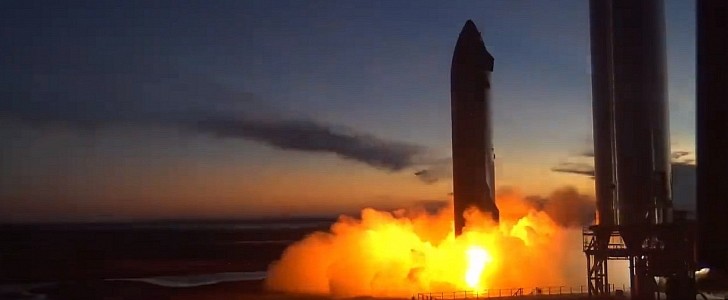It's been several weeks since the SpaceX Mars rocket prototype has been waiting to take off in what will be its first orbital test flight at the company's Starbase facility, near the South Texas town of Boca Chica. And while there's no word when the big day will come, SpaceX is carrying on with the preparations, testing the rocket's powerful Raptor engines.
The Starship system is a reusable two-stage rocket vehicle with a stainless steel hull that consists of the Super Heavy booster and a spaceship, also known as Starship, that is designed to carry passengers and cargo to low Earth orbit, the Moon, and, eventually, Mars.
The latest SpaceX Starship prototype, known as Starship SN20, arrived at the company's launch site back in August. The rocket joined the Super Heavy booster, and we saw how the fully stacked thing looked like for the first time.
It's a massive beast, standing 395 feet (120 meters) tall. Given its size, the hardware needs sufficient power to get off the ground. To that end, the company plans to equip the Super Heavy with 29 Raptors (that's how SpaceX calls its engines) and the Starship with six.
In preparation for its flight, the engines have been undergoing extensive testing. Out of those six Raptors, three are vacuum-optimized, which means that they feature a larger nozzle specifically designed for space propulsion.
On Thursday night (October 21st), SpaceX fired up its SN20 prototype. It was the first "static fire" test for a Raptor vacuum engine integrated onto the Starship.
But even though things are progressing at the site, there's still a long way to go until we see the rocket leave our skies. The company was supposed to launch the prototype in July, but that clearly didn't happen.
For now, it's still unsure when the first orbital test flight will take place. The U.S. Federal Aviation Administration (FAA) has recently released a draft programmatic environmental assessment of SpaceX's future plans for Starship launch operations from the Boca Chica launch site. The agency will accept public reviews on the draft until November 1st, then incorporate them into the final report.
The latest SpaceX Starship prototype, known as Starship SN20, arrived at the company's launch site back in August. The rocket joined the Super Heavy booster, and we saw how the fully stacked thing looked like for the first time.
It's a massive beast, standing 395 feet (120 meters) tall. Given its size, the hardware needs sufficient power to get off the ground. To that end, the company plans to equip the Super Heavy with 29 Raptors (that's how SpaceX calls its engines) and the Starship with six.
In preparation for its flight, the engines have been undergoing extensive testing. Out of those six Raptors, three are vacuum-optimized, which means that they feature a larger nozzle specifically designed for space propulsion.
On Thursday night (October 21st), SpaceX fired up its SN20 prototype. It was the first "static fire" test for a Raptor vacuum engine integrated onto the Starship.
But even though things are progressing at the site, there's still a long way to go until we see the rocket leave our skies. The company was supposed to launch the prototype in July, but that clearly didn't happen.
For now, it's still unsure when the first orbital test flight will take place. The U.S. Federal Aviation Administration (FAA) has recently released a draft programmatic environmental assessment of SpaceX's future plans for Starship launch operations from the Boca Chica launch site. The agency will accept public reviews on the draft until November 1st, then incorporate them into the final report.
First firing of a Raptor vacuum engine integrated onto a Starship pic.twitter.com/uCNAt8Kwzo
— SpaceX (@SpaceX) October 22, 2021






